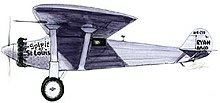Earth inductor compass

An earth inductor compass (or earth inductor ) is a compass that determines north direction using electromagnetic induction . The earth's magnetic field serves as an induction field for an electric generator . The output voltage of the generator changes in relation to its position in the earth's magnetic field. By measuring these voltage changes, the direction of the magnetic north pole is determined.
history
Donald M. Bliss applied for a patent for the earth inductor compass in 1912. In 1920 it was further developed by Paul R. Heyl and Lyman James Briggs of the United States National Bureau of Standards and again in 1924 by Morris Titterington of the Pioneer Instrument Company in Brooklyn , New York . In 1922, Heyl and Briggs were awarded the American Philosophical Society's Magellanic Premium for their work . Since the earth inductor compass compensates for the weaknesses of the magnetic compass , it was a more stable and reliable navigational instrument for pilots . The earth inductor was used, for example, by the United States Army Air Corps in the two Douglas World Cruisers during the first flight around the world in 1924. Charles Lindbergh also used an earth inductor for navigation on his transatlantic flight with the Spirit of St. Louis in 1927. by Lindbergh on the stretch over the Atlantic Ocean - a distance of about 2,000 mi (3,219 km ) - using dead reckoning per hour as determined by the grounding inductor once his position, he could see the coast of Ireland with an accuracy of 10 mi (16 km), that is an error of less than one percent.
function
The original design by Bliss consists of two anchors that are rotatably mounted on a common, vertical axis . Both armatures are each connected to a set of commutators that are rotated ninety degrees from one another. If one of the commutator sets is aligned with the earth's magnetic field, no current will flow. In the event of a deviation from this alignment, a current is induced which is proportional to the sine of the deviation angle. Since the sine has its maximum at ninety degrees, a certain current can indicate either a certain direction or the exact opposite direction. The current induced in the second set of commutators can be used to distinguish between the two possible directions.
The direction of movement can be determined by comparing two independent galvanometers - one for each armature. The galvanometers must first be calibrated with a known direction, since the rotation speed of the armature and magnetic stray fields can influence the measurements.
Later models made it easier to read by showing the deviation from the desired course. They allowed the user to orient the commutators so that no current was induced when the aircraft was moving in the desired direction. A single galvanometer indicated whether the pilot was steering too far to the left or too far to the right.
Lindbergh's compass used an anemometer to rotate the anchors using a universal joint . The anchors were mounted with a cardanic suspension in order to compensate for the movements of the aircraft around the transverse and longitudinal axes , since an inclination of the anchors would have changed the orientation to the earth's magnetic field and led to incorrect readings. The rotating anchors were stabilized in their position by the gyroscopic effect .
Patents
- Patent US1047157 : Device for Determining Direction. Published December 17, 1912 , Applicant: Charles J. Henschel, Inventor: Donald M. Bliss.
- Patent US1840911 : Induction compass. Registered July 8, 1931 , published January 12, 1932 , applicant: Nicolas Minorsky, inventor: Nicolas Minorsky.
- Patent US2434324 : Earth inductor compass. Published January 13, 1948 , Applicant: Control Instrument Company Inc, Inventor: Henry Lehde.
- Patent GB314786 : Improvements in electro-magnetic apparatus for the observation and correction of travel of aerial and marine craft. Published December 23, 1929 , Applicant: Eugene Vion, Inventor: Eugene Vion.
Individual evidence
- ↑ Earth's magnetic field through induction. LEIFIphysik, accessed on March 8, 2020 .
- ^ Brice Goldsborough: The Earth inductor compass . In: Aero Digest . Aeronautical Digest Publishing Corporation, New York July 1927 (English, eaavintage.org [PDF]).
- ^ Paul R. Heyl, Lyman J. Briggs: The earth inductor compass . In: Proceedings of the American Philosophical Society . tape 61 , no. 1 . American Philosophical Society , April 22, 1922, pp. 15-32 , JSTOR : 984431 (English).
- ↑ a b The Earth Inductor Compass. Wings Publishing, archived from the original ; accessed on March 8, 2020 (English).
- ^ A b Charles A. Lindberg: The Spirit of St. Louis . Poolbeg Press, Dublin 1953, ISBN 1-85371-912-9 , pp. 153,194 (English).